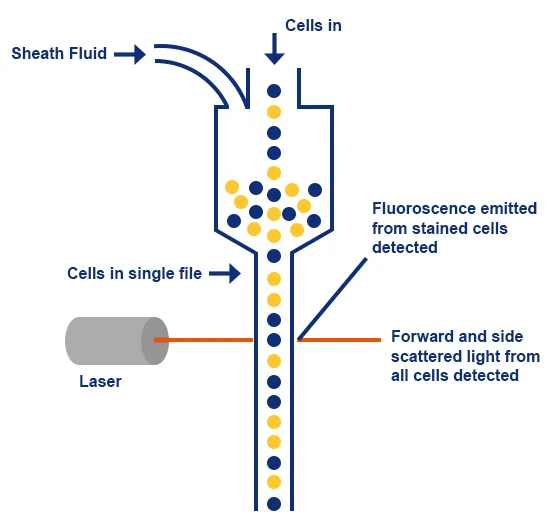What Tests Diagnose CLL?

CLL specialists Drs. Matthew Butler and Ravi Vij share what tests are used to diagnose CLL. Watch their interview below:
Chronic lymphocytic leukemia (CLL) is usually diagnosed based on blood work and not with more invasive procedures like a bone marrow biopsy.
Complete Blood Count
The first indication that a patient has CLL usually comes from when they visit their primary care provider during a routine checkup and their complete blood count (CBC) test shows a high level of white blood cells.
The patient’s primary care provider will want to look more closely at the types of white blood cells. They’ll have the patient meet with a hematologist (a specialist who studies the blood) to complete another CBC test this time adding a differential. The differential portion means that they are specifically looking at the different types of white blood cells.

After the CBC with differential test, if the specific cells that appear high are B-cells, the patient should receive a flow cytometry test.
Flow Cytometry
Flow cytometry checks for certain proteins on the surface of the B-cell’s membrane. Different cancers will have a common protein pattern on the cell’s surface (immunophenotype). The B-cell will be labeled as CLL if proteins CD5, CD19, and CD23 are on the B-cell’s surface. Some CLL cells may also have surface protein CD20. To classify as CLL, the cells should not have surface protein CD10.

(Image source: NCCN)
The test is completed by the specialist taking a sample of the patient’s blood. They then mix the sample with a solution that includes fluorescent dyed antibodies to attach to each of the CLL cell’s specific proteins (CD5, CD19, CD20, and CD23). The sample is placed into the flow cytometer machine and the cells move single file past a laser.
As the laser shines on each cell, the fluorescent antibody markers that have attached to the cell’s proteins will illuminate their dyed color. The computer records information from the test. A diagnosis of CLL is made if the test results show there are at least 5,000 copies of the same CLL cell. If there are less than 5,000 CLL cells, then the disease is categorized as a pre-cursor state to CLL called monoclonal B-cell lymphocytosis.

(Image source: Abbexa)
SLL and Lymph Node Biopsy
If a patient’s doctor finds CLL cells in the blood and the patient’s lymph nodes are also enlarged, the patient should receive a lymph node biopsy. This is usually done with a needle to collect a small sample of lymph tissue. If further lymph tissue is needed, a surgeon may remove a larger piece of a lymph node to examine.
This will help determine if the cancer cells have built up in the lymph nodes. If the majority of cancer cells are in the lymph nodes, this is referred to as small lymphocytic lymphoma (SLL). The cancer cells are the same as CLL, but the buildup location is different.

Blood tests especially flow cytometry, play an important role in detecting and confirming CLL. By analyzing lymphocytes and their characteristics, blood cancer specialists can diagnose CLL with a high degree of accuracy allowing for timely and appropriate management of the cancer.
See here for more lab tests CLL patients can expect to receive.
CLL specialists Drs. Matthew Butler and Ravi Vij share what tests are used to diagnose CLL. Watch their interview below:
Chronic lymphocytic leukemia (CLL) is usually diagnosed based on blood work and not with more invasive procedures like a bone marrow biopsy.
Complete Blood Count
The first indication that a patient has CLL usually comes from when they visit their primary care provider during a routine checkup and their complete blood count (CBC) test shows a high level of white blood cells.
The patient’s primary care provider will want to look more closely at the types of white blood cells. They’ll have the patient meet with a hematologist (a specialist who studies the blood) to complete another CBC test this time adding a differential. The differential portion means that they are specifically looking at the different types of white blood cells.

After the CBC with differential test, if the specific cells that appear high are B-cells, the patient should receive a flow cytometry test.
Flow Cytometry
Flow cytometry checks for certain proteins on the surface of the B-cell’s membrane. Different cancers will have a common protein pattern on the cell’s surface (immunophenotype). The B-cell will be labeled as CLL if proteins CD5, CD19, and CD23 are on the B-cell’s surface. Some CLL cells may also have surface protein CD20. To classify as CLL, the cells should not have surface protein CD10.

(Image source: NCCN)
The test is completed by the specialist taking a sample of the patient’s blood. They then mix the sample with a solution that includes fluorescent dyed antibodies to attach to each of the CLL cell’s specific proteins (CD5, CD19, CD20, and CD23). The sample is placed into the flow cytometer machine and the cells move single file past a laser.
As the laser shines on each cell, the fluorescent antibody markers that have attached to the cell’s proteins will illuminate their dyed color. The computer records information from the test. A diagnosis of CLL is made if the test results show there are at least 5,000 copies of the same CLL cell. If there are less than 5,000 CLL cells, then the disease is categorized as a pre-cursor state to CLL called monoclonal B-cell lymphocytosis.

(Image source: Abbexa)
SLL and Lymph Node Biopsy
If a patient’s doctor finds CLL cells in the blood and the patient’s lymph nodes are also enlarged, the patient should receive a lymph node biopsy. This is usually done with a needle to collect a small sample of lymph tissue. If further lymph tissue is needed, a surgeon may remove a larger piece of a lymph node to examine.
This will help determine if the cancer cells have built up in the lymph nodes. If the majority of cancer cells are in the lymph nodes, this is referred to as small lymphocytic lymphoma (SLL). The cancer cells are the same as CLL, but the buildup location is different.

Blood tests especially flow cytometry, play an important role in detecting and confirming CLL. By analyzing lymphocytes and their characteristics, blood cancer specialists can diagnose CLL with a high degree of accuracy allowing for timely and appropriate management of the cancer.
See here for more lab tests CLL patients can expect to receive.

about the author
Megan Heaps
Megan joined HealthTree in 2022. She enjoys helping patients and their care partners understand the various aspects of the cancer. This understanding enables them to better advocate for themselves and improve their treatment outcomes.
More on HealthTree Programs
Trending Articles
Upcoming Events

Get the Latest Chronic Lymphocytic Leukemia Updates, Delivered to You.
By subscribing to the HealthTree newsletter, you'll receive the latest research, treatment updates, and expert insights to help you navigate your health.














